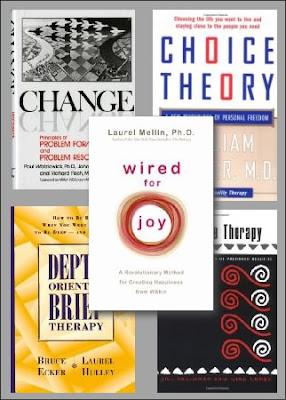
I am very impressed with the EBT model presented in Wired for Joy by Laurel Mellin. One way to convey how valuable I'm finding this book is to situate it among four other outstanding books in the therapeutic field. Wired for Joy replicates or improves on successes in these other approaches to changing our minds, moods and behaviors.
It's easy to produce temporary change that snaps back to the status quo after a interim show of improvement. This was defined as "first order change" in the seminal book: Change: Principles of Problem Formation and Problem Resolution. Wired for Joy avoids this pitfall superbly. Making change at the neurological level produce lasting change (second order change). the EBT model makes a change in how change happens from merely understanding the problem in a better way, getting advice on solutions or agreeing to try something different. Making the change for oneself sets up an enduring improvement, unlike attempting to change via dependency on a professional therapist, surrogate parent or wise elder. The second order change also occurs because Wired for Joy realizes how the change is stressful to an already stressed out mind and how our emotions need our acceptance as well as strenuous upgrades.
When the tools in Wired for Joy get successfully applied, people experience a "pop"; a felt shift in their mood. This experience suggests a change in neuropeptide production as well. This reminds me of "third and fourth order changes" defined in Depth Oriented Brief Therapy. These profound experiences do not occur when a therapist makes a pathological diagnosis of the symptomatic problem or the client gets stuck complaining and trying to get rid of that problem. The transformation of outlook, self concept and worldview occurs when the "pro-symptom stance" gets understood and accepted. The "emotional truth of the symptom" comes to the surface, resonates deeply and evokes a feeling of relief that the underlying impulses make sense in their own context.
When we suffer from over-reacting to provocations or getting consumed by compulsive urges, we identify with the problem. We think "I am this", not "I have this problem" or "this happens to me sometimes". One of the breakthroughs in Narrative Therapy occurs when the client externalizes the problem. They consider "what gets into me sometimes" and "what does it want". They tell a different story about what happens without their being the problem. This also occurs within the EBT model. Users of these tools realize "it's only a wire" and "this too shall pass". Getting wired for stress is something that happens to everyone. Getting wired for joy is something that can happen to anyone who chooses to upgrade their brain circuits.
Back in the eighties, a new approach to psychological interventions emerged called "brief therapy". It was repeatedly shown that significant results could be produced in six weeks that had not been realized in five years of conventional therapy. Some of the practitioners became alarmed that they were falling into the trap of telling clients how to live, rather than empowering clients to live as they choose. Wired for Joy escapes this trap by giving clients the tools for each brain state and the framework for identifying their current brain state. Users of the EBT model are effectively empowered to resolve their issues on their own schedule with their own motivations.
Wired for Joy draws a distinction between hedonic and eudonic pleasures. This parallels the difference between "pleasure worlds" and "quality worlds" in Choice Theory. William Glasser's research into addictive behaviors found the people were not getting their need for authentic relationships met. This lack of congruence resulted from getting controlled, manipulated and isolated, which then produced symptomatic behaviors. The lures of pleasure worlds became addictive because the need to compensate for deprivations was incessant. When authentic relating replaces getting controlled, their other needs get met, their intrinsic pleasures seem more fulfilling and they felt much more congruent. Wired for Joy also captures these upgrades in relationships and the switch to getting personal needs met according to reliable feelings (in Brain State 2).
As I've made all these connections between my reading of Wired for Joy and some of my other favorite books, I've found all these ways to appreciate the high quality of the EBT approach. I'm also finding facets of the approach I would do differently with the intention of making it even more effective and accessible. (to be continued)
No comments:
Post a Comment